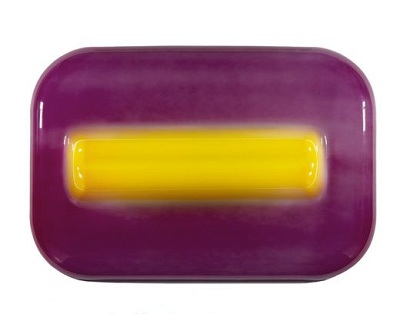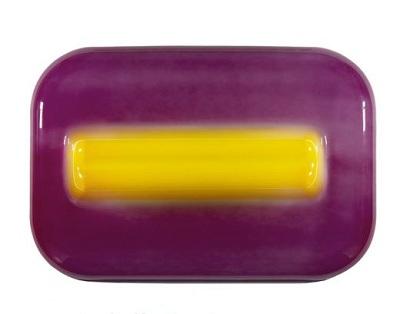A refabrication of this famously broken Craig Kauffman work will make its debut in the Ahmanson Building on Thursday. We asked contemporary curator Howard Fox to write about the original, the new version, and the curatorial issues they inspire.
 Craig Kauffman, Untitled, 1967, © Estate of Craig Kauffman
Craig Kauffman, Untitled, 1967, © Estate of Craig Kauffman
LACMA is about to re-acquire a signature work by a major artist associated with the SoCal Light and Space movement of the 1960s and '70s: Craig Kauffman's 1967 Untitled Wall Relief, one of his best-known and widely illustrated works, made of spray-painted acrylic lacquer on vacuum-formed Plexiglas. Re-acquire? How can that be?
Longtime visitors to LACMA may be well-acquainted with the sleek, capsule-like, wall-bound object acquired as a gift of the Kleiner Foundation in 1973. Turgid and puffy, the plastic body of the work was spray-painted on its interior in a pinky-magenta color reminiscent of grape-flavored bubblegum or some exotic shade of nail polish and sported a tumescent banana-yellow streak bulging horizontally across its center. In his groundbreaking study of California art, Sunshine Muse: Art on the West Coast, 1945-1970, first published in 1974, the artist/critic Peter Plagens celebrated Kaufman's elegant yet audacious Plexiglas paintings, vaunting their "verily immoral color combinations (magenta/yellow, orange/blue)" and lauding them as "unashamedly perfumy objet[s] d'art." LACMA's wall relief—surely the piece Plagens had in mind when he invoked "magenta/yellow"—is arguably a signature work for this artist.
Untitled Wall Relief was exhibited many times in LACMA's permanent collection and was featured in numerous important exhibitions, including LACMA's 1981 survey Art in Los Angeles: Seventeen Artists in the Sixties; LACMA's 2000 extravaganza, Made in California: Art, Image, and Identity, 1900-2000; a Kauffman survey in La Jolla; and in other exhibitions in San Francisco, San Antonio, and Ft. Worth; and was last seen in Paris in the 2006 exhibition Los Angeles 1955–1985: Birth of an Artistic Capital at the Centre Pompidou.
There, a museum worker walked into the Level 6 special exhibition galleries one day to discover the work lying on the floor, severely—fatally—damaged. Sections at the edge had broken off in the fall leaving gaps as obvious as missing teeth, and though the rest of the object remained intact, it suffered multiple fractures and one out-and-out break as significant as the San Andreas Fault. The pristine sleekness of the piece—its very aesthetic integrity—was in ruin. To this day, nobody who investigated the unfortunate incident knows for sure how it occurred. And, except in forensic inquiry, how it happened really doesn't matter. The work was lost. In the aftermath, LACMA, the Centre Pompidou, and the artist agreed that it was appropriate to attempt to re-fabricate the work under the artist's supervision in Los Angeles. The Centre Pompidou worked directly with Kauffman to cover the costs of shipping and re-fabrication, while the Pompidou's insurance paid LACMA the then-current market value of the work; the artist has graciously agreed to LACMA's use of that sum to purchase the 2008 re-fabrication of Untitled Wall Relief.
To anyone familiar with the 1967 original, there is no question that this is its twin. And yet, there are significant differences. The coloration of the original was slightly more candy-like and goofy—what Plagens called "immoral" and "perfumy"—while this new incarnation is somewhat more ruby-tinted, like port wine, and its yellow is slightly more egg-yolky. Yet it is a vital piece in its own right, with all the edginess and spunk of the original. Purists and some aestheticians might question the notion of this new work's authenticity, denouncing it as an "impostor" or a surrogate put forth in lieu of its lost forebear. Indeed, this wall relief of 2008 is a separate object; but it has the same artistic DNA: Kaufman himself cast the new work directly from the carcass of the original, and he mixed the colors himself. The re-fabrication was executed completely under Kauffman's control, and he was satisfied with the result. The interests and hopes of both the artist and LACMA's contemporary curators—to recover a lost work of art—were congruent. The artist's satisfaction with the result informed LACMA's curatorial thinking as well.
We may question how relevant elusive notions of authenticity are in this case. Since the 1960s, many artists working in such directions as minimalism, conceptual art, and new media have created artworks that are replicable without limit. Carl Andre arranges industrially manufactured copper and lead panels in checkerboard patterns on the floor but is not responsible for any other physical or formal aspect of his sculptures; Sol LeWitt's wall drawings are formulated by written instructions conceived by the artist but executed by someone else; Lynn Hershman makes interactive works that exist only in cyberspace and are equally "authentic" when viewed or manipulated on anybody's computer. In all these instances, the mythic hand of the artist—the inspired vision and unique virtuoso "touch" of the creative genius—are simply not a factor or an issue in the aesthetics of the art.
Similarly, Craig Kauffman's Untitled Wall Relief, while unquestionably the creation of the artist's aesthetic choices and sensibility, is fabricated by vacuum-formation, a mechanical process to shape plastic sheeting on a mold through the application of heat, pressure, and vacuum action. There are various technologies, some obsolete, to vacuform plastic and to spray-paint its colors, but they are industrial technologies, not ones associated with traditional ateliers. Kauffman's 2008 wall relief is of course not the selfsame object as the 1967 original. Yet the new work is not necessarily to be regarded as less authentically a creation of Kauffman any more than photographic prints made from a master negative and printed long after the original picture has been taken are any less "authentic" than earlier prints—even if there are discernible differences among them and though vintage prints command a higher market value—as long as they are authorized by the photographer. Assertions about the sanctity of an initial iteration of a work can be misguided; in cases where the fabrication is largely mechanical and the artist has assented to the result, common sense should avoid "fetishizing" the original.
LACMA owns two other Plexiglas paintings by Craig Kauffman and many works on paper. With the mishap of the irreparable damage to Untitled Wall Relief of 1967, LACMA lost a significant work from its internationally respected collection of Southern California art. The work's re-embodiment in this new object brings its history full circle and enables the work to remain represented in the collection.
Howard N. Fox
Senior Curatorial Fellow, Contemporary Art



